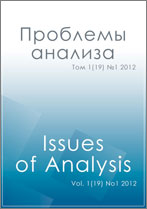|
This article is cited in 6 scientific papers (total in 6 papers)
A shock layer arising as the source term collapses in the $p(\boldsymbol{x})$-Laplacian equation
S. N. Antontsevab, I. V. Kuznetsovcb, S. A. Sazhenkovbc
a CMAF-CIO, University of Lisbon,
Campo Grande 1749-016, Lisbon, Portugal
b Lavrentyev Institute of Hydrodynamics SB RAS,
630090, 15, Prospect Lavrentyeva, Novosibirsk, Russia
c Novosibirsk State University,
630090, 1, Pirogova Street, Novosibirsk , Russia
Abstract:
We study the Cauchy–Dirichlet problem for the $p(\boldsymbol{x})$-Laplacian equation with a regular finite nonlinear minor term. The minor term depends on a small parameter $\varepsilon>0$ and, as $\varepsilon\to 0$, converges weakly$^\star$ to the expression incorporating the Dirac delta function, which models a shock (impulsive) loading. We establish that the shock layer, associated with the Dirac delta function, is formed as $\varepsilon\to 0$, and that the family of weak solutions of the original problem converges to a solution of a two-scale microscopic-macroscopic model. This model consists of two equations and the set of initial and boundary conditions, so that the ‘outer’ macroscopic solution beyond the shock layer is governed by the usual homogeneous $p(\boldsymbol{x})$-Laplacian equation, while the shock layer solution is defined on the microscopic level and obeys the ordinary differential equation derived from the microstructure of the shock layer profile.
Keywords:
parabolic equation, nonstandard growth, variable nonlinearity, non-instantaneous impulse, energy solution, shock layer.
Received: 25.08.2020
Revised: 28.10.2020
Accepted: 28.10.2020
Citation:
S. N. Antontsev, I. V. Kuznetsov, S. A. Sazhenkov, “A shock layer arising as the source term collapses in the $p(\boldsymbol{x})$-Laplacian equation”, Probl. Anal. Issues Anal., 9(27):3 (2020), 31–53
Linking options:
https://www.mathnet.ru/eng/pa305 https://www.mathnet.ru/eng/pa/v27/i3/p31
|

| Statistics & downloads: |
| Abstract page: | 159 | | Full-text PDF : | 82 | | References: | 25 |
|




 Contact us:
Contact us: Terms of Use
Terms of Use
 Registration to the website
Registration to the website Logotypes
Logotypes








 Citation in format
Citation in format 
